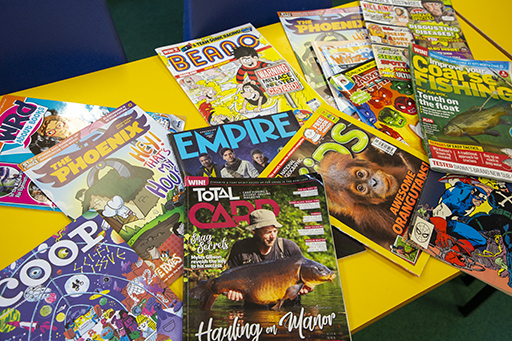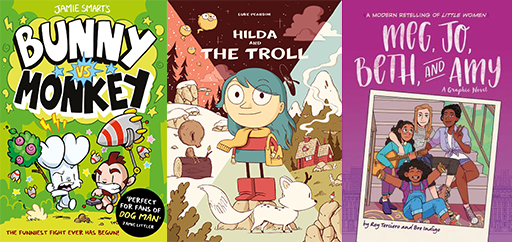2 The affordances and benefits of different children’s texts
Motivation to read and engagement in reading are key factors that enable children to develop as readers (Gambrell, 2011). When educators continually develop their knowledge of children’s texts and get to know texts in depth, they are better positioned to develop a successful Reading for Pleasure pedagogy in school and more effectively foster children’s desire to read.

Different text types have different features and formats which may benefit readers in various ways. Texts with a lower density in the written script, such as picture storybooks can appear more manageable and may be more appealing to younger or struggling readers. Yet, the interpretation of images requires critical thinking and involves no less depth of engagement than other text types (Roche, 2014). Comics and graphic novels can also be visually enticing and an ‘unthreatening’ read for less confident or reluctant readers (Griffith 2010), however the subject matter and choice available may appeal to older children.
Novels and short stories provide opportunities for sustained reading engagement and developing reading stamina. As the narrative develops, these texts evoke the imagination and prompt the reader to predict, hypothesise and relate the plot to their own experience. The interactive figure below will help you to think about the benefits of textual features of different children’s texts.
The potential benefits of different types of text highlighted in Figure 2 show how important it is for educators to read a wide range of children's texts in order to be able to recommend the right text to the right child at the right time. Each genre of children’s texts includes an expansive range of topics. For example, whilst graphic novels tend to be associated with comic books, classics and fantasy fiction have also been presented in this format. You then have poetry, which is often highlighted for its range of forms and use of language, but can also be light-hearted and very accessible to read. It also provides opportunities to read aloud and perform and there is a wealth of poetry freely available online to watch and listen to. Similarly, non-fiction texts can entice children when the subject matter links to personal interest and passions. Non-fiction texts and magazines can also be ‘dipped into’, or equally, they may encourage sustained reading.

Activity 2 Selecting appropriate texts for young readers
Read the case studies of three different readers and consider what type of text or specific title/author you might offer to them to encourage widening of their reading repertoire. Make a note of the reason for your choice.
- Ruby says that she doesn’t like to read, but if encouraged she usually reads non-fiction texts and says she prefers books about History and Geography. The appeal of non-fiction for Ruby seems to be that she can read small chunks of information and dip in and out of the text. She also often comments on the illustrations and photographs in her reading.
- Nafiul doesn’t choose books to read. His favourite activity at home is console games, but he has recently shown an interest in The Beano and The Phoenix comics during independent reading time. He will pick out a joke or a funny storyline and share it with others at his table.
- Connor struggles to read fluently and independently and does not have a wide vocabulary, which makes comprehension difficult. He enjoys creating his own drawings and paintings, and in Science and Geography he has shown a passionate interest in animals and nature. Recently he has responded thoughtfully to the poetry that the teacher has been reading aloud in class. Specifically, he has talked about how the poems made him feel.
Comment
In the classroom, you would no doubt look at the available texts with Ruby, Nafiul and Connor and chat about what they might like to try. In this activity, you may have struggled because you do not have detailed knowledge of these children’s reading abilities or previous reading. However, some possible ideas could be:
- Offering Ruby a comic or magazine to read. These could include longer stories such as those in The Phoenix or articles about non-fiction topics such as ‘Eco Kids planet’. Sharing a hybrid non-fiction picture book might encourage her to read something more narrative.
- Nafiul might be enticed by something funny and visual. Graphic novels could be a good choice for him. The Bunny and Monkey series by Jamie Smart could lead on from the familiar characters in The Phoenix comic. Alternatively, he might be interested in an amusing illustrated poetry collection such as The Book of not Entirely Useful Advice by A.F. Harrold, illustrated by Mini Grey.
- Connor might enjoy some short reading material that doesn’t overwhelm him. Offering him some picture books or poetry with a nature theme and touching message could help him to connect with his reading in a new way.
Although you should help to guide young readers with text suggestions, be wary of pressing your recommendations on the children. Instead, by offering a choice of ‘texts that tempt’ they will retain a sense of their own agency as readers. This activity may have reinforced the importance of continually enhancing your own knowledge of children’s texts.
The suggestions in the box below offer some practical ways to help you develop your knowledge of children’s literature and other texts. Whatever you choose, be sure to share with others that you are on this journey, seek encouragement and voice your views about the texts as you read them.
Box 1 Ways to develop you knowledge of children’s texts
- Target texts that reflect diversities
- Read award winners
- Choose a genre and get focused!
- Identify one author, one illustrator and one poet – become their greatest fan!
- Agree with a friend to set targets together
- Invite your class to set you a reading challenge
- Participate in the annual Teachers’ Reading Challenge [Tip: hold Ctrl and click a link to open it in a new tab. (Hide tip)] (June–September)
- Read to your knee in books (stack up the books you read until you reach your knee in height!)
- Take the 4-books-a-month challenge
- Turn to Twitter to ask for recommendations, then read each one!
- Find inspiration from The Open University’s Reading for Pleasure webpage on Texts and Authors
- For more ideas visit The Open University’s Reading for Pleasure website
